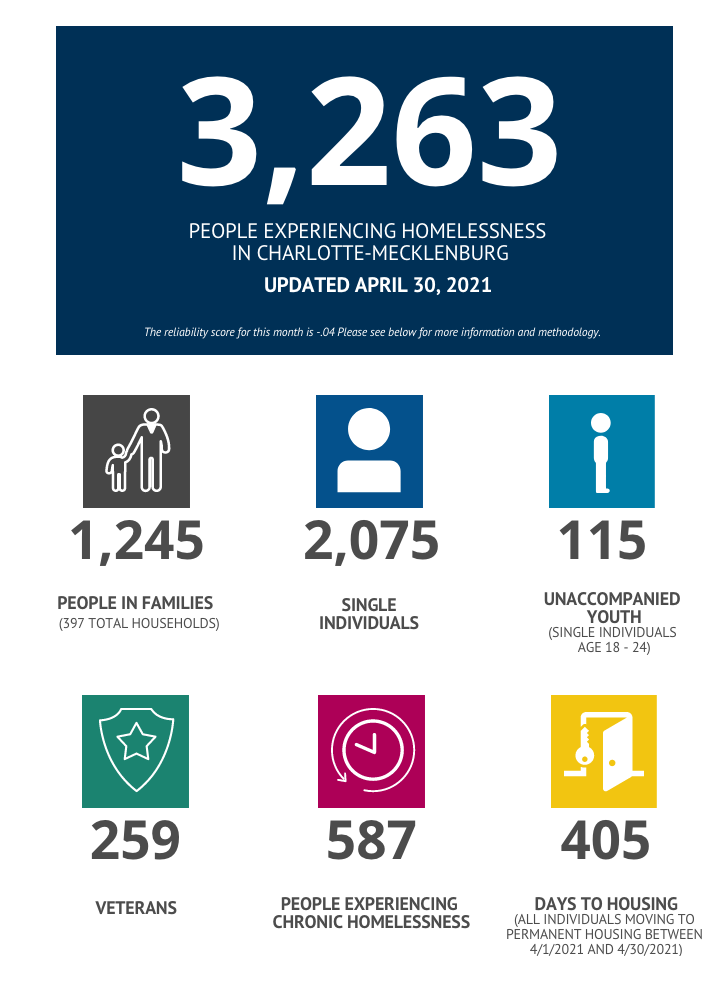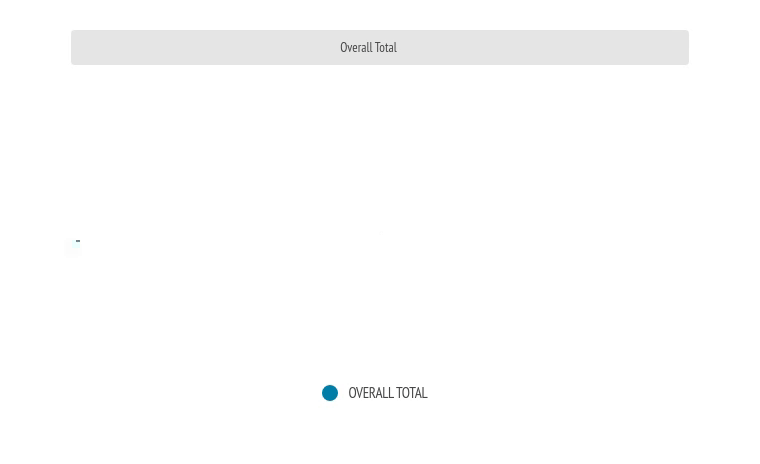Courtney LaCaria
Housing & Homelessness Research Coordinator
Mecklenburg County Community Support Services
Kimberly Sanders
HMIS Management Analyst
Mecklenburg County Community Support Services
Mecklenburg County Community Support Services first released the “One Number” in 2019 as part of the annual Charlotte-Mecklenburg State of Housing Instability & Homelessness Report. Since that initial release, the One Number has become the “go-to” for the count of people who are experiencing homelessness in Charlotte-Mecklenburg.
The One Number is found on the Housing Data Snapshot, a hub for the latest information related to housing and homelessness in Charlotte-Mecklenburg. Generated from a By-Name List within the Homeless Management Information System (HMIS), the One Number captures the number of people enrolled in Emergency Shelter; Transitional Housing; Street Outreach; Rapid Re-housing (those enrolled but not yet housed); and Coordinated Entry inventories in HMIS.
The One Number includes both total sheltered homelessness and a portion of the individuals experiencing unsheltered homelessness in Charlotte-Mecklenburg. In addition, the One Number can be broken down by both household composition and population type; elements include single individuals, families, unaccompanied youth, veterans, and people experiencing chronic homelessness. The One Number can also be analyzed by inflow to, and outflow from, homelessness. By comparing One Number data over time (including by household composition or by inflow/outflow), the community can identify trends. Once identified, these trends can then inform interventions. To read more about how the One Number works, click here.
This week’s blog post provides the most recent One Number update; latest trends and analyses; and what this means for Charlotte-Mecklenburg.
LATEST DATA & TRENDS
As of April 30, 2021, there are 3,263 individuals experiencing homelessness in Charlotte-Mecklenburg. This total includes 2,075 single individuals (of which 115 are unaccompanied youth); and 397 families (comprised of 1,245 people). Included in the total of 3,263 individuals are 259 homeless Veterans, and 587 individuals who are experiencing chronic homelessness.
To view the historical data, please click here.
Considering inflow (into homelessness) and outflow (out of homelessness), here are some noteworthy trends:
- Between February and April 2021, there was a 193 person decrease in the total number of people experiencing homelessness. In fact, since February 2021, overall inflow into homelessness has been steadily decreasing (from 680 in February to 467 in April); and overall outflow from homelessness has been increasing (from 340 in February to 626 in April). Like the previous month, it is important to note that this decrease could be due in part to data cleanup related to the 2021 Point-in-Time. Of the total outflow reported between February and April 2021, 56% (807 individuals) exited to permanent housing whereas 44% (634 individuals) exited to inactive status (meaning they have not been engaged with a provider in the services system in the last 90 days).
- Despite the slight decrease observed last month, there has been a 61% (or 1,238 person) increase in overall homelessness since June 2020. As context, it is important to note that, during this period and in response to COVID-19, the community’s temporary shelter capacity has increased, including through the provision of hotel rooms. This data clearly reflects the continued need for housing assistance resulting from the pandemic.
- Change in homelessness between March and April 2021 varied by the type of household composition and the category of homelessness. Between March and April 2021, the number of families increased by 4; the number of single individuals decreased by 32; and unaccompanied youth decreased by 9. In addition, Veterans experiencing homelessness remained constant (inflow equaled outflow); people experiencing chronic homelessness decreased by 13 individuals.
- According to the latest One Number data, disaggregated by race and ethnicity, individuals who identify as Black/African American continue to experience homelessness at rates much higher than their proportion of the Mecklenburg County population (77% vs. 33%) while individuals who identify as White, non-Hispanic experience homelessness at a rate much lower than their prevalence in the population (14% vs 47%). Individuals who identify as Hispanic/Latino have a prevalence of 3% in the homeless population but comprise 14% of the Mecklenburg County population; this reflects a possible underrepresentation of the people who experience homelessness in Charlotte-Mecklenburg and identify as Hispanic/Latino. In addition, the average length of time to housing for individuals identifying as Black/African American was 423 days; this compares to 322 days for individuals who identified as White, non-Hispanic; 220 days for individuals who identify as American Indian or Alaskan Native; and 189 days for individuals identifying as Asian. For those who identified as Hispanic/Latino, the average length of time to housing was 733 days, versus 386 days for those who identify as Non-Hispanic/Non-Latino.
SO, WHAT
The One Number is the best snapshot available for the number of people experiencing homelessness in Charlotte-Mecklenburg. But, like all data, the One Number also has its limitations. First, the One Number is still an undercount of all people experiencing homelessness. It does not (yet) include all households experiencing homelessness through residency in hotels and/or motels; or living in “doubled up” situations with family and/or friends. Therefore, it is helpful to think of the One Number as the floor: it is the most accurate minimum count of the number of people actively experiencing homelessness in the community. As the latest One Number indicates, the minimum number of people (adults and children) experiencing homelessness (and therefore, the minimum number of housing units and/or subsidies needed right now) in Charlotte-Mecklenburg is 3,263.
The national eviction moratorium enacted by the U.S. Centers for Disease Control and Prevention is set to expire in less than a month. This has slowed, but not fully stopped, the inflow into homelessness. Since the start of the pandemic, almost $85 billion has been appropriated in emergency housing and homelessness assistance through the American Rescue Plan Act; the December COVID-19 relief bill; and the Coronavirus Aid, Relief, and Economic Security (CARES) Act. The recently proposed American Jobs Plan would add an additional $318 billion in housing-related investment.
However, many households who are eligible for this new infusion of assistance have not been able to access it. The $46.55 billion Emergency Rental Assistance (ERA) program, which can provide up to 18 months of assistance, is one example. There are over 340 programs attempting to administer ERA program dollars to struggling households. But, according to a recent article surveying the ERA program landscape, it is unlikely that all ERA program dollars will get into the hands of households and/or landlords before the moratorium expires. And, the negative implications are vast: increases in households becoming homelessness; fewer affordable housing units available as landlords are forced to make tough decisions.
To help ensure ERA program dollars get to as many households who need it as possible, the U.S. Treasury Department provided guidance to communities. It is up to each community to put these funds to use so that every household has a fighting chance to stay home.
SIGN UP FOR BUILDING BRIDGES BLOG
Courtney LaCaria coordinates posts on the Building Bridges Blog. Courtney is the Housing & Homelessness Research Coordinator for Mecklenburg County Community Support Services. Courtney’s job is to connect data on housing instability, homelessness and affordable housing with stakeholders in the community so that they can use it to drive policy-making, funding allocation and programmatic change.
Kimberly Sanders is the Homeless Management Information Systems (HMIS) Management Analyst for the Charlotte-Mecklenburg Continuum of Care (CoC). She is responsible for the CoC’s reporting to HUD, and provides reporting support and training to 25+ agencies that serve individuals and families who are homeless or at risk of homelessness. Kimberly is also a member of the Data Advisory Committee.



